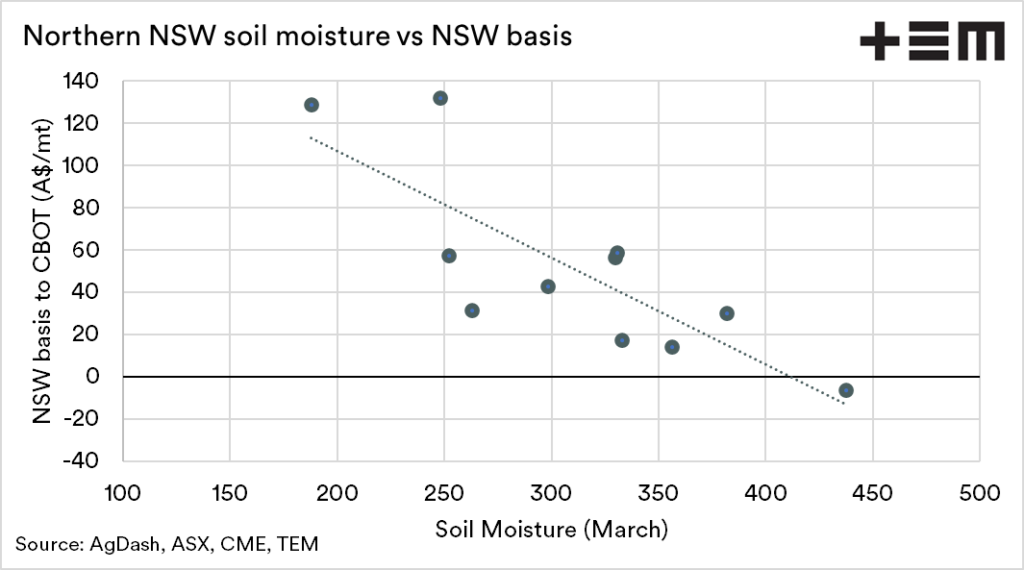Raining in the basis.

The Snapshot
- The rainfall in large parts of the east coast has been strong.
- Rainfall has lead to promising soil moisture levels in the lead up to seeding.
- There is a strong correlation between high soil moisture in March and high soil moisture in the important June/September growing period.
- There is a strong link between high soil moisture in New South Wales and annual basis levels.
- Higher soil moisture = higher yields = higher production = lower basis.
- The conditions are in place for the coming harvest. If average or above-average rainfall comes, then NSW is likely to produce a good crop.
- New South Wales largely sets pricing for the eastern states.
The Detail
The final curtain call of the La Nina may have provided a gift through large tracts of NSW. Whilst its horrific to see the damage caused to friends properties, it does have one advantage to the farming fraternity. It has set up the soil moisture profile well for the coming seeding.
It got me thinking about the price impact that moisture has.
As we all know, high soil moisture leads to high yields. The soil moisture information for New South Wales will be available for March in the coming days, we don’t know the exact number, but we can expect it to be high.
I decided not to look at the overall (flat) price for wheat because this is influenced mainly by events overseas. Instead, I opted to only look at basis, as this is directly moved by conditions locally. If you want to understand basis more, read here.
Mad March
The chart below shows the relationship between soil moisture* in March for Northern NSW vs the NSW annual basis. The correlation of this relationship is -0.8.
A correlation of 1 would be considered perfect in that as one goes up, the other goes up. In this case, the relationship has a strong negative correlation. As soil moisture increases, the annual basis decreases.
March doesn’t make a crop
After more than a decade of living in Australia and commenting on grain, I have one major lesson. The Australian climate can throw a spanner in the works, and it does so regularly. It’s dangerous to call the crop early in the year because a good start could turn dry, and vice versa.
So when does the soil moisture really matter?
The crop is made in the June-September period. That is when the soil moisture makes a difference. The correlation between basis and soil moisture becomes strong, -0.96 for this period.
This shows that the soil moisture in June-September is an important driver of production, and therefore basis.
This is logical, and it is what we would expect to be the case. However, how does rainfall inat the start of the year relate to later on? Is it just a tease?
March flows, flow through.
So how often does a moist March result in good moisture through the growing period? I have compared the Jan, Feb and March soil moisture to see the relationship between each month and the growing season.
The correlations are:
- January 0.58
- February 0.773
- March 0.78
The correlation between March and the growing season moisture is stronger than in earlier months. Again, this is logical. Firstly, it is closer, but the temperature is lower, therefore less evaporation, leading to more soil moisture being banked.
The rainfall received during March in NSW and the subsequent high soil moisture is likely to lead to decent conditions through the growing season. The solid conditions, in turn, can lead to lower basis levels versus Chicago.
Basis is a two-edged sword; we want a substantial premium versus the rest of the world. However, a substantial premium usually means lower production. A low basis level usually equates to strong production.
There is more than can be done to assist profitability in a low basis year than having no grain to sell. The ideal scenario will be another year of high production locally and events overseas, driving our pricing higher.
*Soil moisture = mm in top 0-1.6m of soil






